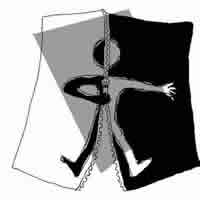Difference between Borderline and Sociopath
Key Difference: Borderline Personality Disorder is a mental condition in which people experience reckless and impulsive behavior, unstable moods and relationships. Sociopath is a medical condition that results in a person’s way of thinking, relating, dealing with situations and perceiving situations to become destructive. People suffering from this order have a difficulty in distinguishing between right and wrong.
Borderline and sociopath are two different kind of mental conditions that people can suffer from. Sociopath is actually a very common mental disorder and according to statistic a person may encounter at least one sociopath during their lifetime. Sociopath is actually an informal name for Antisocial Personality Disorder. These two could also coexist in a person, making treatment very difficult. These are two different disorders and should not be mistaken as the other.

Borderline Personality Disorder is a mental condition in which people experience reckless and impulsive behavior, unstable moods and relationships. The disorder was not considered as a medical condition until the 1980s, when the Diagnostic and Statistical Manual for Mental Disorders, Third Edition (DSM-III) listed this condition as a medical diagnosable illness. BPD patients usually suffer brief psychotic mood swings that often change in minutes or hours. Experts state that people suffering from BPD also often suffer from other mental disorders such as depression, anxiety disorders, substance abuse, eating disorder, suicidal behaviors, etc. The overlapping of these disorders makes it difficult to properly diagnose and treat the disease.
According to research, BPD is known to occur three times more in women than in men. In women, the disorder is believed to co-occur with depression, anxiety and eating disorders. In men, it co-occurs with substance abuse and personality disorder. The disorder usually begins at a young age during adolescence or early childhood. Some childhood experiences have also been known to cause or trigger the disorder. Causes for the disorder include history of childhood trauma, brain abnormalities, genetic predisposition, neurobiological factors, environmental factors, executive function, family environment, self-complexity and thought suppression.
According to the DSM Fourth Edition, for a person to be diagnosed with BPD, they must exhibit at least five of the following symptoms: Extreme reactions of panic, depression, rage, etc., intense and stormy relationships, unstable self-image, impulsive and reckless behavior, suicidal tendencies, self-harming behavior, feelings of emptiness, uncontrollable anger and rage, paranoia, losing touch with reality, etc.
BPD has been unofficially divided into four subtypes by American psychologist, Theodore Million. He proposes that an individual diagnosed with the disorder can be classified into one oof the four categories depending on their symptoms. Wikipedia lists the four subtypes as:
- Discouraged borderline — including avoidant, depressive or dependent features
- Impulsive borderline – including histrionic or antisocial features
- Petulant borderline – including negativistic (passive-aggressive) features
- Self-destructive borderline – including depressive or masochistic features
Psychotherapy has been a proven to help treat patients with BPD. It has shown to help relieve some symptoms. Different types of therapy that are used include cognitive behavioral therapy, dialectical behavior therapy, and schema-focused therapy. Cognitive behavioral therapy (CBT) helps people identify and change core beliefs and behaviors that the patient may have about themselves along with addressing mood, anxiety problems and suicidal behaviors. Dialectical behavior therapy (DBT) focuses on helping the patient being aware and attentive to the present situation and allowing them to control and take charge of their emotions. Schema-focused therapy combines CBT with other forms of therapy and focuses on altering the way the patient views themselves. Medications are also used along with psychotherapy to relieve certain symptoms. Other treatments that have shown positive effect include an omega-3 healthy diet for women.
 Sociopath is a medical condition that results in a person’s way of thinking, relating, dealing with situations and perceiving situations to become destructive. People suffering from this order have a difficulty in distinguishing between right and wrong. In legal terms a sociopath is actually a person suffering from antisocial personality disorder. According to Mayo Clinic website, sociopath is a severe form of antisocial personality disorder. The American Psychiatric Association's Diagnostic and Statistical Manual, fourth edition (DSM-IV-TR) defines Antisocial personality disorder (ASPD) as "...a pervasive pattern of disregard for, and violation of, the rights of others that begins in childhood or early adolescence and continues into adulthood."
Sociopath is a medical condition that results in a person’s way of thinking, relating, dealing with situations and perceiving situations to become destructive. People suffering from this order have a difficulty in distinguishing between right and wrong. In legal terms a sociopath is actually a person suffering from antisocial personality disorder. According to Mayo Clinic website, sociopath is a severe form of antisocial personality disorder. The American Psychiatric Association's Diagnostic and Statistical Manual, fourth edition (DSM-IV-TR) defines Antisocial personality disorder (ASPD) as "...a pervasive pattern of disregard for, and violation of, the rights of others that begins in childhood or early adolescence and continues into adulthood."
The Diagnostic and Statistical Manual of Mental Disorders, fourth edition (DSM IV-TR) states the symptoms of the disorder as:
- Failure to conform to social norms with respect to lawful behaviors as indicated by repeatedly performing acts that are grounds for arrest.
- Deception, as indicated by repeatedly lying, use of aliases, or conning others for personal profit or pleasure.
- Impulsiveness or failure to plan ahead.
- Irritability and aggressiveness, as indicated by repeated physical fights or assaults.
- Reckless disregard for safety of self or others.
- Consistent irresponsibility, as indicated by repeated failure to sustain consistent work behavior or honor financial obligations.
- Lack of remorse, as indicated by being indifferent to or rationalizing having hurt, mistreated, or stolen from another.
According to the manual the person must be at least 18 in order to be diagnosed properly, though their symptoms could manifest before that. The ASPD is also known to common coexist with other types of personality disorders as well as substance abuse. Theodore Milton classifies the ASPD disorder into five subtypes:
- Covetous antisocial – variant of the pure pattern where individuals feel that life has not given them their due.
- Reputation-defending antisocial – including narcissistic features
- Risk-taking antisocial – including histrionic features
- Nomadic antisocial – including schizoid, avoidant features
- Malevolent antisocial – including sadistic, paranoid features.
A number of different causes have been linked to causing the disorder including hormones and neurotransmitters such as serotonin. External triggers such as family relations, traumatic experiences, etc. can disrupt the standard development of the central nervous system resulting in the brain releasing hormones that can change the normal pattern of development. Certain studies have also found a connection between limbic neural maldevelopment and ASPD. Cultural influences and the environment that the person grew up in can also trigger the ASPD or help control the disorder. Therapy has been a proven treatment of ASPD as well as medications for certain symptoms, disorders or substance abuse.
|
|
Borderline |
Sociopath |
|
Definition |
Borderline personality disorder is a condition during which a person exhibits unstable moods, behavior and relationships. They are also associated with reckless behavior and suicidal tendencies. |
Antisocial Personality Disorder is a disorder in which a person exhibits a persistent pattern of disregard for rules and laws. They constant lie and manipulate without regard for anything but their own wellbeing. |
|
Symptoms |
Extreme reactions, intense relationships, impulsive decisions and behavior, suicidal tendencies, extensive mood swings, feelings of emptiness, intensive and uncontrollable anger. |
Failure to conform to social norms, laws, deception, impulsive and reckless behavior, aggressiveness, uncontrollable anger, inconsistent responsibility and lack of remorse. |
|
Causes |
History of childhood trauma, brain abnormalities, genetic predisposition, neurobiological factors, environmental factors, executive function, family environment, self-complexity and thought suppression. |
Hormones, neurotransmitters, limbic neural maldevelopment, cultural influences and environment. |
|
Types |
BPD has been unofficially been divided into four types by Theodore Million: Discouraged borderline, Impulsive borderline, Petulant borderline and Self-destructive borderline. |
Theodore Million divides antisocial personality disorder into five subtypes: Covetous antisocial, Reputation-defending antisocial, Risk-taking antisocial, Nomadic antisocial and Malevolent antisocial |
|
Treatment |
Psychotherapy, Medications, mental health services. |
Therapy has been proven as the best measure for treating antisocial personality disorder. |
Image Courtesy: beautifulwreck1.wordpress.com, kernelmag.com









Add new comment